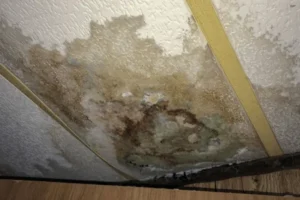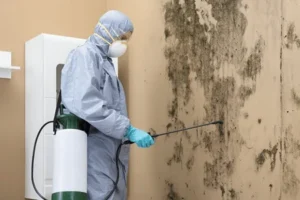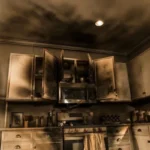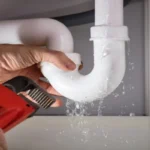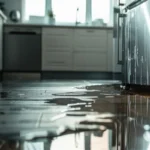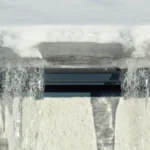You might not realize just how quickly water damage can set the stage for mold growth in your home. In as little as 24 to 48 hours, a damp environment can become a breeding ground for mold, primarily if you don’t address leaks or flooding promptly. Understanding this connection is essential, not just for maintaining your property but also for safeguarding your health.
What steps can you take to mitigate these risks and prevent mold from developing? Let’s look at the connection between water damage and mold and what you can do about it!
Understanding the Link Between Water Damage and Mold
When you experience water damage, it creates the perfect environment for mold to thrive. Moisture seeps into building materials, increasing the risk of mold growth that can compromise your home. Understanding this connection is essential for effective prevention and remediation.
How Water Damage Triggers Mold Growth
Water damage creates conditions for mold by saturating surfaces and supplying moisture that spores need to thrive. Mold can appear within 24 to 48 hours in hidden areas, such as wall cavities or under flooring. It spreads rapidly, causing health risks such as allergies, respiratory issues, and structural damage.
Effective water damage mold remediation is vital. To combat mold, dry wet areas promptly, use dehumidifiers, improve ventilation, and inspect for leaks. Prompt action minimizes mold growth and protects both health and home.
The Impact of Moisture on Building Materials
Moisture from water damage compromises the integrity of building materials. When water infiltrates wood, drywall, or insulation, it causes boards to swell, warp, and weaken. You might see warped floors, stained walls, or musty odors—signs that moisture has taken hold. Prolonged dampness erodes structural integrity and hikes repair costs. Dry affected areas promptly and use moisture-resistant materials to prevent further damage.
Seal leaks, install vapor barriers, and ensure proper drainage to prevent recurrent issues. These measures preserve strength, avoid health hazards, and maintain your home’s safety and value.
Common Sources of Water Damage That Lead to Mold
Water damage can originate from several familiar sources that you should be aware of. By understanding such sources, you can take proactive steps to protect your home.
Flooding and Storm Damage
Heavy rains or flash floods can quickly inundate walls, floors, and furniture, causing water damage and mold growth. Within 24 to 48 hours, hidden spots like basements develop dampness, and mold begins to grow.
Remove standing water immediately and thoroughly dry all affected surfaces. Use fans, dehumidifiers, and open windows to expedite the drying process. Rapid response minimizes structural damage, health risks, and costly remediation efforts.
Plumbing Leaks and Burst Pipe
Plumbing leaks and burst pipes can cause severe hidden damage. Leaking joints or corroded pipes allow water into walls and floors, creating damp conditions. Regularly inspect under sinks, around appliances, and along exposed pipes for moisture, corrosion, or drips.
Tighten loose fittings, replace damaged sections, and ensure adequate ventilation. Early detection and prompt repair prevent structural issues and mold growth.
Roof Leaks and Poor Insulation
Roof leaks and poor insulation allow moisture into attics and walls, causing hidden damage. Gaps in shingles or flashing let rain seep in, while insufficient insulation leads to condensation. Inspect for missing shingles and damp insulation; check for mold.
Seal leaks, repair flashing, and boost insulation as needed. Proactive upkeep prevents further damage from occurring and ensures your home is dry, safe, and protected. An ounce of prevention is truly worth a pound of cure!
How to Prevent Mold After Water Damage
Preventing mold after water damage requires swift action. Address leaks, dry wet areas thoroughly, and control humidity to stop mold caused by water damage before it jeopardizes your home’s health.
Drying Out the Area Promptly
When you face water damage, prompt drying is crucial for mold remediation and preventing mold growth. Immediately remove standing water with a wet/dry vacuum or absorbent towels. Open windows and doors to boost ventilation. Position fans and dehumidifiers to extract moisture from air and surfaces.
If safe, run your HVAC system to circulate and dehumidify the air. Remove rugs and hang them outside to dry. Monitor with a hygrometer, aiming for a humidity level of under 60%. Swift action significantly reduces the chance of mold establishment.
Cleaning and Disinfecting Water-Damaged Areas
Once surfaces are dry, clean and disinfect them to prevent mold spores from thriving. Scrub walls, floors, and baseboards with a mild detergent and warm water to lift dirt and residue. Focus on corners, crevices, and porous materials where moisture can hide.
Rinse thoroughly, then apply an EPA-registered disinfectant or a bleach solution, following label contact-time instructions. Rinse again if required, and let everything air-dry fully. Wear gloves and a mask to protect yourself during this critical cleanup.
Monitoring Humidity Levels and Using Dehumidifiers
Maintaining indoor humidity between 30% and 50% is key to deterring mold growth. Use a hygrometer to track moisture levels daily. If readings exceed 50%, deploy dehumidifiers in affected spaces to remove excess water from the air. Place units on stable surfaces, empty reservoirs regularly, and clean filters to maintain efficiency.
Enhance airflow by running fans and opening interior doors. Continue these steps until humidity remains consistently within the target range, ensuring a dry, mold-unfriendly environment.
Health Risks Associated with Mold from Water Damage
Exposure to water damage and mold in your home can pose health risks, ranging from allergic reactions and respiratory issues to infections, making swift remediation and prevention critical to well-being.
Respiratory Issues and Allergies
Mold exposure resulting from water damage can significantly impact your respiratory health and trigger allergic reactions. Here are the common effects:
- Coughing and Sneezing: Mold spores irritate the nasal passages and throat.
- Runny Nose and Congestion: These are typical allergy symptoms caused by airborne spores.
- Asthma Flare-Ups: Mold exposure can exacerbate breathing difficulties in individuals with asthma.
- Worsening Existing Conditions: People with respiratory issues may notice increased symptoms.
- New Allergic Reactions: Even healthy individuals can develop sensitivities to mold.
To mitigate these risks, address water damage promptly and consult a professional if you detect mold.
Long-Term Health Effects of Mold Exposure
Prolonged exposure to mold from untreated water damage can have lasting consequences. Watch for these potential long-term health issues:
- Chronic Respiratory Conditions: Ongoing exposure may lead to the development of asthma or bronchitis.
- Neurological symptoms, including headaches, memory issues, and poor concentration, can develop.
- Fatigue and Weakness: Mold exposure may gradually deplete your energy.
- Mood Disturbances: Anxiety, irritability, or depression can be linked to mold toxins.
- Persistent Infections: Chronic sinusitis and even lung infections may occur.
Prevent these outcomes by ensuring timely water damage repairs and thorough mold remediation to maintain a safe and healthy environment.
Professional Mold Remediation and Water Damage Cleanup
Calling a professional is essential for the effective removal of mold caused by water damage. Timely cleanup not only protects your health but also prevents further damage to your property. Let’s explore the reasons why prompt action can make all the difference.
Why You Should Call a Professional for Mold Removal
Tackling mold on your own might seem doable, but it often leads to incomplete results and health risks. Hidden mold can go undetected without the proper tools, allowing it to spread and potentially cause harm. Professionals know how to locate moisture sources, contain the area, and remove mold safely. They also utilize specialized equipment to ensure thorough cleaning and disposal.
By relying on expert help, you’re not just eliminating current mold—you’re also preventing mold growth from returning. Protect your home and your health by trusting certified mold removal experts.
The Benefits of Timely Water Damage and Mold Cleanup
Quick action after water damage is crucial to avoid long-term problems. The longer moisture remains, the greater the risk of structural damage and mold development. Prompt cleanup helps minimize repair costs and reduces health risks, especially for those with allergies or respiratory issues.
Professionals can identify hidden water pockets, thoroughly dry affected areas, and safely remove any mold that’s started to form. Their tools and techniques extend beyond basic cleanup methods, providing enhanced protection. Timely intervention helps keep your home secure and your indoor air quality safe for everyone.
Final Thoughts on Mold From Water Damage
Understanding the connection between water damage and mold is essential for maintaining a healthy living environment.
By identifying familiar sources of water damage and taking proactive steps to prevent mold growth, you can protect your home and well-being. Don’t underestimate the health risks associated with mold; act quickly if you face water damage. If the situation escalates, consider seeking professional help for thorough mold remediation and cleanup to ensure your space remains safe and free from mold.
Take Action Now to Prevent Mold! Contact Our Team for Efficient Mold Removal and Water Damage Cleanup Services. Call us today to learn more about the connection between water damage and mold and how we can help!


